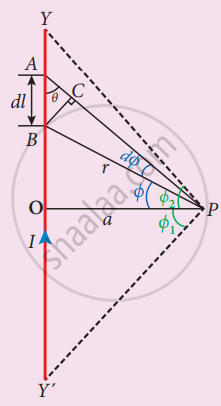Advertisements
Advertisements
प्रश्न
Deduce the relation for the magnetic induction at a point due to an infinitely long straight conductor carrying current.
उत्तर
Consider a long straight wire NM with current I flowing from N to M. Let P be the point at a distance a from point O. Consider an element of length dl of the wire at a distance l from point O and `vec"r"` be the vector joining the element dl with the point P. Let θ be the angle between `vec"dl" and vec"r"`. Then, the magnetic field at P due to the element is d`vec"B" = (mu_0"I"vec"dl")/(4pi"r"^2)` sinθ (unit vector perpendicular to `vec"dl" and vec"r"`) ....(1)
The direction of the field is perpendicular to the plane of the paper and going into it. This can be determined by taking the cross product between two vectors `vec"dl" and vec"r"` (let it be `hat"n"`). The net magnetic field can be determined by integrating the equation with proper limits.

Magnetic field due to a long straight current-carrying conductor
`vec"B" = int "d"vec"B"`
From the figure, in a right angle triangle PAO,
tan (π – θ) = `"a"/l`
I = `"a"/(tan theta)` (since tan (π – θ) = -tan θ) ⇒ `1/(tan theta)`
l = a cot θ and r = a cosec θ
differentiating,
dl = a cosec2 θ dθ
`"d"vec"B" = (mu_0"I")/(4pi) (("a" cosec^2theta "d"theta))/("a" cosec theta)^2 (sin theta "d" theta hat"n")`
`= (mu_0"I")/(4pi) (("a" cosec^2theta "d"theta))/("a"^2 cosec^2 theta) (sin theta "d" theta hat"n")`
`"d"vec"B" = (mu_0"I")/(4pi"a") sin theta "d" theta hat"n"` ...(2)
This is the magnetic field at a point P due to the current in small elemental length. Note that we have expressed the magnetic field OP in terms of angular coordinate i.e. θ. Therefore, the net magnetic field at the point P which can be obtained by integrating d`vec"B"` by varying the angle from θ = (φ1 to θ = φ1) is
`vec"B" = (mu_0"I")/(4pi"a")int_(φ_2)^(φ_1) sin theta "d"theta hat"n" = (mu_0"I")/(4pi"a") (cosφ_1 - cosφ_2) hat"n"`
For a an infinitely long straight wire, 1 = 0 and 2 = , the magnetic field is
`vec"B" = mu_0/(2pi"a") hat"n"` .....(3)
Note that here `hat"n"` represents the unit vector from the point O to P.
APPEARS IN
संबंधित प्रश्न
State Biot-Savart’s law.
How is a galvanometer converted into
- an ammeter and
- a voltmeter?
Obtain a relation for the magnetic induction at a point along the axis of a circular coil carrying current.
What is tangent law? Discuss in detail.
Discuss the conversion of galvanometer into an ammeter and also a voltmeter.
